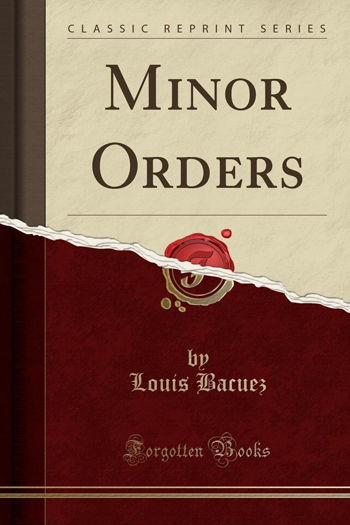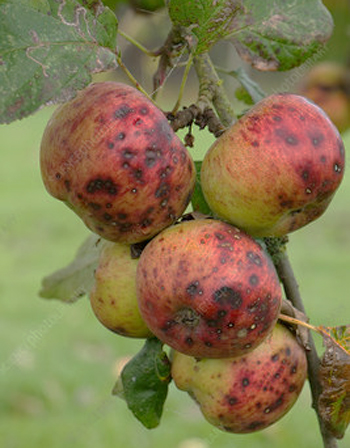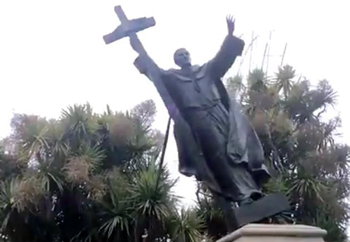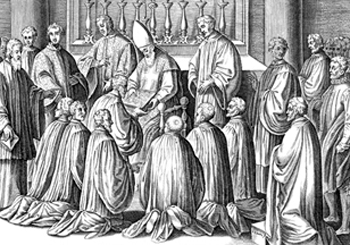Traditionalist Issues
 |
 |
 |
 |
 |
 |
 |
Dialogue Mass - CX
Pre & Post Liturgical Movement Attitudes to Minor Orders
When we compare the traditional view of Minor Orders with the treatment they received at the hands of liturgical reformers in the 20th century, it becomes evident that the two positions stand in dire contrast to each other. To illustrate this point in greater depth, let us turn again to the exposition of Minor Orders made by Fr. Louis Bacuez who modestly introduced his magnum opus as follows:
 “This little book is a sequel to one we have published on Tonsure. God grant that those who make use of it may conceive a great respect for Minor Orders and prepare for them as they should! The dispositions with which they approach ordination will be the measure of the graces they receive, and on this measure depends, in a great part, the fruit that their ministry will produce. To have a rich harvest the first thing necessary is to sow well: Qui parce seminat parce et metet; et qui seminat in benedictionibus de benedictionibus et metet. (2 Cor. 9:6)” (1)
“This little book is a sequel to one we have published on Tonsure. God grant that those who make use of it may conceive a great respect for Minor Orders and prepare for them as they should! The dispositions with which they approach ordination will be the measure of the graces they receive, and on this measure depends, in a great part, the fruit that their ministry will produce. To have a rich harvest the first thing necessary is to sow well: Qui parce seminat parce et metet; et qui seminat in benedictionibus de benedictionibus et metet. (2 Cor. 9:6)” (1)
Little did he realize that when he wrote these words every vestige of respect for the Minor Orders would be whittled away by the concerted efforts of progressivists with a negative and dismissive attitude towards them; and that the Liturgical Movement, which had just begun when he published his book, would be dominated by influential liturgists discussing how to overturn them.
Long before the term “Cancel Culture” was invented, they presented the Minor Orders as a form of class-based oppression perpetrated by a clerical “caste” and as a form of spiritually empty legalism, and they went to great lengths to make them look ridiculous.
Far from showing due respect, this involves quite a considerable degree of contempt, not only for the generations of seminarians who were formed within this tradition, but also for the integrity of the great institution of Minor Orders that had served the Church since Apostolic times. In fact, so great was their animosity towards the Minor Orders that they could hardly wait to strip them of their essential nature as functions of the Hierarchy and turn them into lay ministries.
A tree is known by its fruits
These, then, were the hate-filled dispositions that inspired the progressivist reform, and would determine the graces received and the fruit to be produced by those who exercise the new lay “ministries” as opposed to, and in place of, the traditional Minor Orders.
Fr. Bacuez, who wrote his book in the pontificate of Pius X, could never, of course, have envisaged the demise of the Minor Orders, least of all at the hands of a future Pope. He was concerned lest even the smallest amount of grace be lost in the souls of those preparing for the priesthood:
 “We shall see, on the Last Day, what injury an ordinand does to himself and what detriment he causes to souls by losing, through his own fault, a part of the graces destined to sanctify his priesthood and render fruitful the fields of the Heavenly Father: Modica seminis detractio non est modicum messis detrimentum. (St. Bernard)” (2)
“We shall see, on the Last Day, what injury an ordinand does to himself and what detriment he causes to souls by losing, through his own fault, a part of the graces destined to sanctify his priesthood and render fruitful the fields of the Heavenly Father: Modica seminis detractio non est modicum messis detrimentum. (St. Bernard)” (2)
We do not, however, need to wait till the Last Day to see the effects of a reform that deliberately prevents, as by an act of spiritual contraception, the supernatural graces of the Minor Orders from attaining their God-given end: “to sanctify the priesthood and render fruitful the fields of the Heavenly Father.” For the evidence is all around us that the tree of this reform produced blighted fruits.
First, we note a weakening of the hierarchical structure of the Church and a blurring of the distinction between clergy and laity; second, a “contraceptive” sterility resulting in vocations withering on the vine and below replacement level, seminaries and churches closing down, parishes dying, and the decline in the life of the traditional Catholic Faith as seen in every measurable statistic. The conclusion is inescapable: those who planted this tree and those who now participate in the reform are accomplices in a destructive work.
Advantages of the Minor Orders
A substantial part of Fr. Bacuez’ exposition of the Minor Orders is devoted to the inestimable benefits they bring to the Church. These he divided into the following three categories:
A significant and entirely appropriate omission was any mention of active involvement of the laity in the liturgy. Fr. Bacuez’ silence on this issue is an eloquent statement of the mind of the Church that the liturgy is the preserve of the clergy.
We will now take each of his points in turn.
1. The honor of the priesthood
“A statue, however perfect, would never be appreciated by most people, unless it were placed on a suitable pedestal. Likewise the pontificate, which is the perfection of the priesthood, would not inspire the faithful with all the esteem it merits, if it had not beneath it, to give it due prominence, these different classes of subordinate ministers, classes inferior one to another, but the least of which is superior to the entire order of laymen.” (3)
 It is an example of dramatic irony that Fr. Bacuez unwittingly chose the theme of a statue supported by a pedestal to illustrate his point. He was not to know that statues of historical figures would become a major source of controversy in the culture wars and identity politics of our age.
It is an example of dramatic irony that Fr. Bacuez unwittingly chose the theme of a statue supported by a pedestal to illustrate his point. He was not to know that statues of historical figures would become a major source of controversy in the culture wars and identity politics of our age.
Nor could he have foreseen that toppling monuments – both metaphorical and concrete – was to become a favorite sport of the 20th-century liturgical reformers, their aim being to exalt the status of the laity by “active participation” in clerical roles. And never in his wildest imagination would he have suspected that a future Pope would join in the iconoclastic spree to demolish the Minor Orders about which he wrote with evident pride and conviction.
'Don’t put the priest on a pedestal'
However, the revolutionaries considered that esteem for the Hierarchy and recognition of its superiority over the lay members of the Church was too objectionable to be allowed to survive in modern society. The consensus of opinion among them was that clergy and laity were equals because of their shared Baptism, and placing the priest on a pedestal was not only unnecessary, but detrimental to the interests of the laity.
“Don’t put the priest on a pedestal” was their battle cry. It is the constant refrain that is still doing the rounds among progressivists who refuse to give due honor to the priesthood and insist on accusing the Church of systemic “clericalism.”
But the fundamental point of the Minor Orders – and the Sub-Diaconate – was precisely to be the pedestal on which the priesthood is supported and raised to a position of honor in the Church. When Paul VI’s Ministeria quaedam dismantled the institutional underpinnings of the Hierarchy, the imposing pedestal and columns that were the Minor Orders and Sub-Diaconate were no longer allowed to uphold and elevate the priesthood.
The biblical underpinnings of the Minor Orders
Fr. Bacuez made use of the following passage from the Book of Proverbs:
“Wisdom hath built herself a house; she hath hewn out seven pillars. She hath slain her victims, mingled her wine, and set forth her table.” (9: 1-2)
 He drew an analogy between “the seven columns of the living temple, which the Incarnate Wisdom has raised up to the Divine Majesty” and all the clerical Orders (four Minor and three Major) that exist for the right worship of God. In this, he was entirely justified. For, in their interpretation of this passage, the Church Fathers concur that it is a foreshadowing of the Holy Sacrifice of the Mass performed, as St. Augustine said, by “the Mediator of the New Testament Himself, the Priest after the order of Melchisedek.” (4)
He drew an analogy between “the seven columns of the living temple, which the Incarnate Wisdom has raised up to the Divine Majesty” and all the clerical Orders (four Minor and three Major) that exist for the right worship of God. In this, he was entirely justified. For, in their interpretation of this passage, the Church Fathers concur that it is a foreshadowing of the Holy Sacrifice of the Mass performed, as St. Augustine said, by “the Mediator of the New Testament Himself, the Priest after the order of Melchisedek.” (4)
In the 1972 reform, no less than five (5) of the seven columns were brought crashing down from their niches in the Hierarchy to cries of “institutionalized clericalism,” “delusions of grandeur” and “unconscious bias” against the laity.
To further elucidate the affinity of the Minor Orders to the priesthood, Fr. Bacuez gave a brief overview of the cursus honorum that comprised the Orders of Porter, Lector, Exorcist, Acolyte, Sub-Deacon, Deacon and Priest before going on to explain their interrelatedness:
“These seven powers successively conferred, beginning with the last, are superimposed one upon the other without ever disappearing or coming in conflict, so that in the priesthood, the highest of them all, they are all found. The priest unites them all in his person, and has to exercise them all his life in the various offices of his ministry.” (6)
After Ministeria quaedam, however, these rights and powers are no longer regarded as the unique, personal possession of the ordained, but have been officially redistributed among the baptized. It was not simply a question of changing the title from Orders to “ministries”: the real locus of the revolution was in taking the privileges of the “ruling classes” (the representatives of Christ the King) and giving them to their subjects (the laity) as of “right.”
The neo-Marxist message was, and still is, that this was an act of “restorative justice” for the laity who had been “historically wronged.” For the liturgical progressivists, 1972 was, apparently, the year of “compensation.”
Continued


Starting the whittling away of respect
for the Minor Orders...
Little did he realize that when he wrote these words every vestige of respect for the Minor Orders would be whittled away by the concerted efforts of progressivists with a negative and dismissive attitude towards them; and that the Liturgical Movement, which had just begun when he published his book, would be dominated by influential liturgists discussing how to overturn them.
Long before the term “Cancel Culture” was invented, they presented the Minor Orders as a form of class-based oppression perpetrated by a clerical “caste” and as a form of spiritually empty legalism, and they went to great lengths to make them look ridiculous.
Far from showing due respect, this involves quite a considerable degree of contempt, not only for the generations of seminarians who were formed within this tradition, but also for the integrity of the great institution of Minor Orders that had served the Church since Apostolic times. In fact, so great was their animosity towards the Minor Orders that they could hardly wait to strip them of their essential nature as functions of the Hierarchy and turn them into lay ministries.
A tree is known by its fruits
These, then, were the hate-filled dispositions that inspired the progressivist reform, and would determine the graces received and the fruit to be produced by those who exercise the new lay “ministries” as opposed to, and in place of, the traditional Minor Orders.
Fr. Bacuez, who wrote his book in the pontificate of Pius X, could never, of course, have envisaged the demise of the Minor Orders, least of all at the hands of a future Pope. He was concerned lest even the smallest amount of grace be lost in the souls of those preparing for the priesthood:

Blighted fruits from a sick tree
We do not, however, need to wait till the Last Day to see the effects of a reform that deliberately prevents, as by an act of spiritual contraception, the supernatural graces of the Minor Orders from attaining their God-given end: “to sanctify the priesthood and render fruitful the fields of the Heavenly Father.” For the evidence is all around us that the tree of this reform produced blighted fruits.
First, we note a weakening of the hierarchical structure of the Church and a blurring of the distinction between clergy and laity; second, a “contraceptive” sterility resulting in vocations withering on the vine and below replacement level, seminaries and churches closing down, parishes dying, and the decline in the life of the traditional Catholic Faith as seen in every measurable statistic. The conclusion is inescapable: those who planted this tree and those who now participate in the reform are accomplices in a destructive work.
Advantages of the Minor Orders
A substantial part of Fr. Bacuez’ exposition of the Minor Orders is devoted to the inestimable benefits they bring to the Church. These he divided into the following three categories:
- The honor of the priesthood;
- The dignity of worship;
- The perfection of the clergy.
A significant and entirely appropriate omission was any mention of active involvement of the laity in the liturgy. Fr. Bacuez’ silence on this issue is an eloquent statement of the mind of the Church that the liturgy is the preserve of the clergy.
We will now take each of his points in turn.
1. The honor of the priesthood
“A statue, however perfect, would never be appreciated by most people, unless it were placed on a suitable pedestal. Likewise the pontificate, which is the perfection of the priesthood, would not inspire the faithful with all the esteem it merits, if it had not beneath it, to give it due prominence, these different classes of subordinate ministers, classes inferior one to another, but the least of which is superior to the entire order of laymen.” (3)

Toppling statues has become popular today:
above, Fr. Serra in central Los Angeles, California
Nor could he have foreseen that toppling monuments – both metaphorical and concrete – was to become a favorite sport of the 20th-century liturgical reformers, their aim being to exalt the status of the laity by “active participation” in clerical roles. And never in his wildest imagination would he have suspected that a future Pope would join in the iconoclastic spree to demolish the Minor Orders about which he wrote with evident pride and conviction.
'Don’t put the priest on a pedestal'
However, the revolutionaries considered that esteem for the Hierarchy and recognition of its superiority over the lay members of the Church was too objectionable to be allowed to survive in modern society. The consensus of opinion among them was that clergy and laity were equals because of their shared Baptism, and placing the priest on a pedestal was not only unnecessary, but detrimental to the interests of the laity.
“Don’t put the priest on a pedestal” was their battle cry. It is the constant refrain that is still doing the rounds among progressivists who refuse to give due honor to the priesthood and insist on accusing the Church of systemic “clericalism.”
But the fundamental point of the Minor Orders – and the Sub-Diaconate – was precisely to be the pedestal on which the priesthood is supported and raised to a position of honor in the Church. When Paul VI’s Ministeria quaedam dismantled the institutional underpinnings of the Hierarchy, the imposing pedestal and columns that were the Minor Orders and Sub-Diaconate were no longer allowed to uphold and elevate the priesthood.
The biblical underpinnings of the Minor Orders
Fr. Bacuez made use of the following passage from the Book of Proverbs:
“Wisdom hath built herself a house; she hath hewn out seven pillars. She hath slain her victims, mingled her wine, and set forth her table.” (9: 1-2)

An ordination to the minor order of exorcist, one of the seven columns
In the 1972 reform, no less than five (5) of the seven columns were brought crashing down from their niches in the Hierarchy to cries of “institutionalized clericalism,” “delusions of grandeur” and “unconscious bias” against the laity.
To further elucidate the affinity of the Minor Orders to the priesthood, Fr. Bacuez gave a brief overview of the cursus honorum that comprised the Orders of Porter, Lector, Exorcist, Acolyte, Sub-Deacon, Deacon and Priest before going on to explain their interrelatedness:
“These seven powers successively conferred, beginning with the last, are superimposed one upon the other without ever disappearing or coming in conflict, so that in the priesthood, the highest of them all, they are all found. The priest unites them all in his person, and has to exercise them all his life in the various offices of his ministry.” (6)
After Ministeria quaedam, however, these rights and powers are no longer regarded as the unique, personal possession of the ordained, but have been officially redistributed among the baptized. It was not simply a question of changing the title from Orders to “ministries”: the real locus of the revolution was in taking the privileges of the “ruling classes” (the representatives of Christ the King) and giving them to their subjects (the laity) as of “right.”
The neo-Marxist message was, and still is, that this was an act of “restorative justice” for the laity who had been “historically wronged.” For the liturgical progressivists, 1972 was, apparently, the year of “compensation.”
Continued
- Louis Bacuez SS, Minor Orders, St Louis MO: B. Herder, 1912, p. x. “He who soweth sparingly shall also reap sparingly; and he who soweth in blessings shall also reap blessings.”
- Ibid., St. Bernard of Clairvaux, Lenten Sermon on the Psalm ‘Qui habitat,’ Sermones de Tempore, In Quadragesima, Preface, § 1: “If, at the time of sowing, a moderate amount of seed has been lost, the harm done to the harvest will not be inconsiderable.”
- Ibid., p. 6.
- St. Augustine, The City of God, book XVII, chap. 20: "Of David’s Reign and Merit; and of his son Solomon, and of that prophecy relating to Christ, which is found either in those books that are joined to those written by him, or in those that are indubitably his."
- These were the four Minor Orders and the Major Order of the Sub-Diaconate.
- L. Bacuez, op. cit., p. 5.

Posted December 10, 2021
______________________
______________________
 Volume I |
 Volume II |
 Volume III |
 Volume IV |
 Volume V |
 Volume VI |
 Volume VII |
 Volume VIII |
 Volume IX |
 Volume X |
 Volume XI |
 Special Edition |


